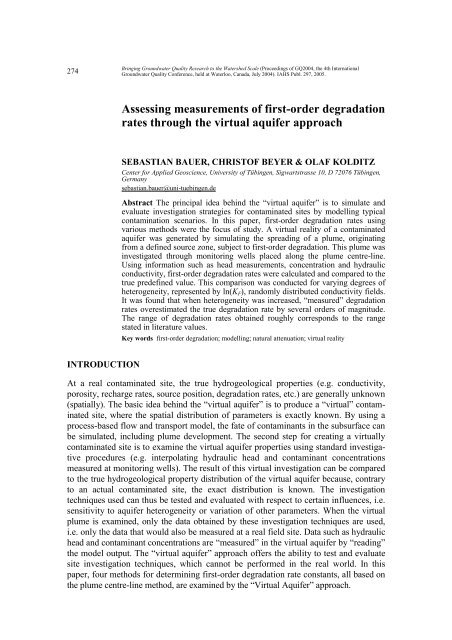Applied numerical modeling of saturated / unsaturated flow and ...
Applied numerical modeling of saturated / unsaturated flow and ...
Applied numerical modeling of saturated / unsaturated flow and ...
Create successful ePaper yourself
Turn your PDF publications into a flip-book with our unique Google optimized e-Paper software.
274<br />
INTRODUCTION<br />
Bringing Groundwater Quality Research to the Watershed Scale (Proceedings <strong>of</strong> GQ2004, the 4th International<br />
Groundwater Quality Conference, held at Waterloo, Canada, July 2004). IAHS Publ. 297, 2005.<br />
Assessing measurements <strong>of</strong> first-order degradation<br />
rates through the virtual aquifer approach<br />
SEBASTIAN BAUER, CHRISTOF BEYER & OLAF KOLDITZ<br />
Center for <strong>Applied</strong> Geoscience, University <strong>of</strong> Tübingen, Sigwartstrasse 10, D 72076 Tübingen,<br />
Germany<br />
sebastian.bauer@uni-tuebingen.de<br />
Abstract The principal idea behind the “virtual aquifer” is to simulate <strong>and</strong><br />
evaluate investigation strategies for contaminated sites by modelling typical<br />
contamination scenarios. In this paper, first-order degradation rates using<br />
various methods were the focus <strong>of</strong> study. A virtual reality <strong>of</strong> a contaminated<br />
aquifer was generated by simulating the spreading <strong>of</strong> a plume, originating<br />
from a defined source zone, subject to first-order degradation. This plume was<br />
investigated through monitoring wells placed along the plume centre-line.<br />
Using information such as head measurements, concentration <strong>and</strong> hydraulic<br />
conductivity, first-order degradation rates were calculated <strong>and</strong> compared to the<br />
true predefined value. This comparison was conducted for varying degrees <strong>of</strong><br />
heterogeneity, represented by ln(KF), r<strong>and</strong>omly distributed conductivity fields.<br />
It was found that when heterogeneity was increased, “measured” degradation<br />
rates overestimated the true degradation rate by several orders <strong>of</strong> magnitude.<br />
The range <strong>of</strong> degradation rates obtained roughly corresponds to the range<br />
stated in literature values.<br />
Key words first-order degradation; modelling; natural attenuation; virtual reality<br />
At a real contaminated site, the true hydrogeological properties (e.g. conductivity,<br />
porosity, recharge rates, source position, degradation rates, etc.) are generally unknown<br />
(spatially). The basic idea behind the “virtual aquifer” is to produce a “virtual” contaminated<br />
site, where the spatial distribution <strong>of</strong> parameters is exactly known. By using a<br />
process-based <strong>flow</strong> <strong>and</strong> transport model, the fate <strong>of</strong> contaminants in the subsurface can<br />
be simulated, including plume development. The second step for creating a virtually<br />
contaminated site is to examine the virtual aquifer properties using st<strong>and</strong>ard investigative<br />
procedures (e.g. interpolating hydraulic head <strong>and</strong> contaminant concentrations<br />
measured at monitoring wells). The result <strong>of</strong> this virtual investigation can be compared<br />
to the true hydrogeological property distribution <strong>of</strong> the virtual aquifer because, contrary<br />
to an actual contaminated site, the exact distribution is known. The investigation<br />
techniques used can thus be tested <strong>and</strong> evaluated with respect to certain influences, i.e.<br />
sensitivity to aquifer heterogeneity or variation <strong>of</strong> other parameters. When the virtual<br />
plume is examined, only the data obtained by these investigation techniques are used,<br />
i.e. only the data that would also be measured at a real field site. Data such as hydraulic<br />
head <strong>and</strong> contaminant concentrations are “measured” in the virtual aquifer by “reading”<br />
the model output. The “virtual aquifer” approach <strong>of</strong>fers the ability to test <strong>and</strong> evaluate<br />
site investigation techniques, which cannot be performed in the real world. In this<br />
paper, four methods for determining first-order degradation rate constants, all based on<br />
the plume centre-line method, are examined by the “Virtual Aquifer” approach.

















